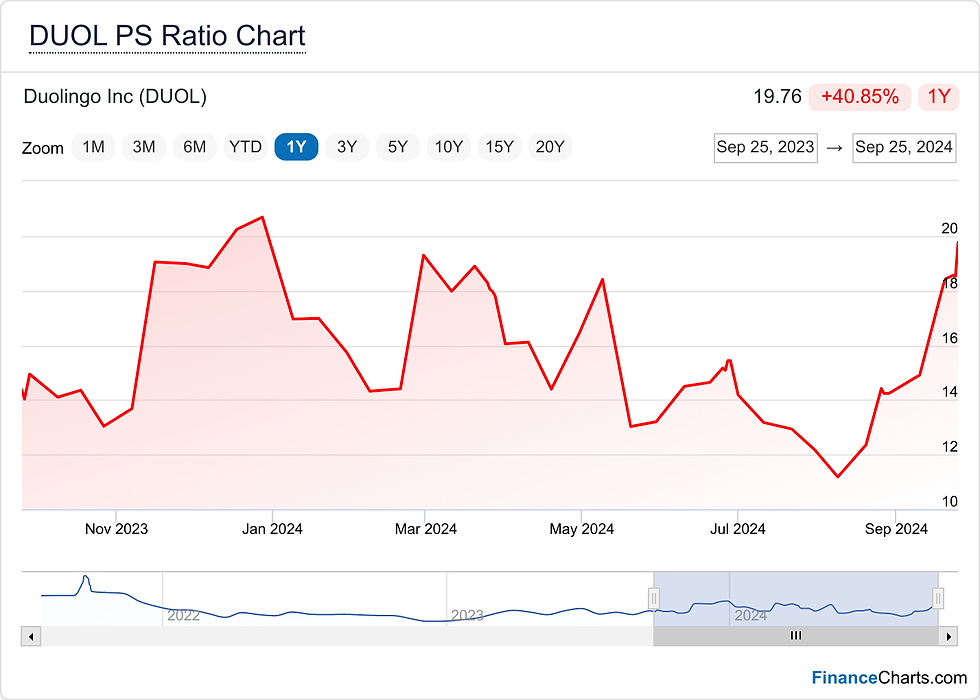Is Duolingo Stock a Buy? Analysing Duolingo’s Monthly Active Users (MAU) & Paid Users Growth trend.
- Max Teh

- Sep 26, 2024
- 3 min read
Updated: Jan 3
Disclaimer: This communication is provided for information purposes only and is not intended as a recommendation or a solicitation to buy, sell or hold any investment product. Readers are solely responsible for their own investment decisions.
Duolingo’s Growth Story: What Investors Need to Know
Duolingo, the world’s leading language-learning platform, is experiencing significant growth in both its monthly active users (MAU) and paid subscriber base. As tech-driven companies like Duolingo increasingly appeal to investors, it's critical to understand whether this app’s growth potential makes it a smart long-term investment.
These numbers signal that Duolingo’s freemium business model is working well, with more users converting to paid subscribers each quarter. This type of trend is common in high-growth tech companies that scale efficiently, such as Spotify and Netflix, where paying customers eventually form the bedrock of profitability.
Why Duolingo’s Paid Subscriber Growth Matters for Investors
Paid subscribers are a crucial metric to watch because they represent recurring revenue, a strong indicator of the company’s ability to generate consistent cash flow. While Duolingo’s MAU growth shows the platform’s increasing popularity, the real value comes from the paying customer base.
Here’s why this is important for investors:
Higher Customer Lifetime Value (CLV): With paid subscriptions, Duolingo enjoys steady revenue streams from loyal users who are less likely to churn.
Monetization Success: The company is successfully converting its free users into paying customers, showing effective upselling strategies.
Sustainable Revenue Growth: A higher percentage of paying users can signal profitability in the long term, which is often a key driver of stock price appreciation.
Freemium Business Model: How Duolingo is Winning Over Users
Duolingo’s freemium business model, where users can access the platform for free but pay for premium features, has proven to be highly effective. With a relatively low barrier to entry, millions of users sign up, creating a massive base of free users. Over time, many of these users are drawn into paying for features like ad-free learning and advanced featurs..
Here are some comparisons:
Spotify: Like Duolingo, Spotify started with a freemium model and has grown its paid subscriber base steadily, leading to stock growth.
Duolingo’s model positions it to follow a similar trajectory, making its stock one to watch.
Looking Ahead: What Duolingo’s Future Growth Could Mean for Investors
With Duolingo expanding its user base globally and launching new products like Duolingo Math & Music, the company’s growth potential extends beyond just language learning. As the world becomes more digital and mobile, the demand for accessible, tech-driven education will continue to grow.
Additionally, Duolingo’s robust data-driven approach to learning provides it with a competitive edge in user retention and engagement. As the company refines its offerings and expands into new markets, the upward trend in MAU and paid subscribers is likely to continue.
Should You Invest in Duolingo Stock?
Duolingo’s increasing MAU, steady rise in paid subscribers, and effective freemium model make it an attractive option for growth investors. While no investment is without risk, Duolingo’s ability to convert free users into paying subscribers and expand its product offerings make it a company with solid long-term potential.
Investors looking for exposure to the tech and education sectors, with a focus on companies with scalable business models, should keep a close eye on Duolingo.
Caution: Duolingo's stock valuation is high at this point
It is currently trading at close to 20X PS ratio, and based on my past observation buying stocks above 18X PS ratio may carry significant valuation risks into your portfolio. (read more on: Avoid Investing in Stocks with PS Ratios Above 18X (when stock is at all-time high level).)
For existing shareholders (as I am myself) it is important to monitor closely to ensure the stock does not get too overvalued.
As for new shareholders who are interested to add new position in the stock, it may be wise to wait until the stock's valuation has reduced when the company increase their LTM revenue figures.
For more about Duolingo, read









Comments